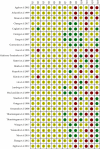What Is the Impact of Depletion of Immunoregulatory Genes on Wound Healing? A Systematic Review of Preclinical Evidence
- PMID: 33488938
- PMCID: PMC7787779
- DOI: 10.1155/2020/8862953
What Is the Impact of Depletion of Immunoregulatory Genes on Wound Healing? A Systematic Review of Preclinical Evidence
Abstract
Cytokines and growth factors are known to play an important role in the skin wound closure process; however, in knockout organisms, the levels of these molecules can undergo changes that result in the delay or acceleration of this process. Therefore, we systematically reviewed evidence from preclinical studies about the main immunoregulatory molecules involved in skin repair through the analysis of the main mechanisms involved in the depletion of immunoregulatory genes, and we carried out a critical analysis of the methodological quality of these studies. We searched biomedical databases, and only original studies were analyzed according to the PRISMA guidelines. The included studies were limited to those which used knockout animals and excision or incision wound models without intervention. A total of 27 studies were selected; data for animal models, gene depletion, wound characteristics, and immunoregulatory molecules were evaluated and compared whenever possible. Methodological quality assessments were examined using the ARRIVE and SYRCLE's bias of risk tool. In our review, the extracellular molecules act more negatively in the wound healing process when silenced and the metabolic pathway most affected involved in these processes was TGF-β/Smad, and emphasis was given to the importance of the participation of macrophages in TGF-β signaling. Besides that, proinflammatory molecules were more evaluated than anti-inflammatory ones, and the main molecules evaluated were, respectively, TGF-β1, followed by VEGF, IL-6, TNF-α, and IL-1β. Overall, most gene depletions delayed wound healing, negatively influenced the concentrations of proinflammatory cytokines, and consequently promoted a decrease of inflammatory cell infiltration, angiogenesis, and collagen deposition, compromising the formation of granulation tissue. The studies presented heterogeneous data and exhibited methodological limitations; therefore, mechanistic and highly controlled studies are required to improve the quality of the evidence.
Copyright © 2020 Bárbara Cristina Félix Nogueira et al.
Conflict of interest statement
The authors declare that there are no conflicts of interest.
Figures






Similar articles
-
Aloesin from Aloe vera accelerates skin wound healing by modulating MAPK/Rho and Smad signaling pathways in vitro and in vivo.Phytomedicine. 2017 May 15;28:19-26. doi: 10.1016/j.phymed.2017.02.005. Epub 2017 Mar 4. Phytomedicine. 2017. PMID: 28478809
-
The essential involvement of cross-talk between IFN-gamma and TGF-beta in the skin wound-healing process.J Immunol. 2004 Feb 1;172(3):1848-55. doi: 10.4049/jimmunol.172.3.1848. J Immunol. 2004. PMID: 14734769
-
Does antibiotic use accelerate or retard cutaneous repair? A systematic review in animal models.PLoS One. 2019 Oct 10;14(10):e0223511. doi: 10.1371/journal.pone.0223511. eCollection 2019. PLoS One. 2019. PMID: 31600279 Free PMC article.
-
Peptides from Animal Origin: A Systematic Review on Biological Sources and Effects on Skin Wounds.Oxid Med Cell Longev. 2020 Oct 23;2020:4352761. doi: 10.1155/2020/4352761. eCollection 2020. Oxid Med Cell Longev. 2020. PMID: 33149808 Free PMC article.
-
Herbal formula Astragali Radix and Rehmanniae Radix exerted wound healing effect on human skin fibroblast cell line Hs27 via the activation of transformation growth factor (TGF-β) pathway and promoting extracellular matrix (ECM) deposition.Phytomedicine. 2012 Dec 15;20(1):9-16. doi: 10.1016/j.phymed.2012.09.006. Epub 2012 Oct 17. Phytomedicine. 2012. PMID: 23083814
Cited by
-
A bibliometric analysis of hotpots and trends for the relationship between skin inflammation and regeneration.Front Surg. 2023 Apr 21;10:1180624. doi: 10.3389/fsurg.2023.1180624. eCollection 2023. Front Surg. 2023. PMID: 37151861 Free PMC article.
-
OxInflammation Affects Transdifferentiation to Myofibroblasts, Prolonging Wound Healing in Diabetes: A Systematic Review.Int J Mol Sci. 2024 Aug 19;25(16):8992. doi: 10.3390/ijms25168992. Int J Mol Sci. 2024. PMID: 39201678 Free PMC article.
-
Mechanisms, Biomarkers, and Therapeutics Involved in Inflammatory Disorders and Tissue Repair 2021.Oxid Med Cell Longev. 2022 Mar 21;2022:9806128. doi: 10.1155/2022/9806128. eCollection 2022. Oxid Med Cell Longev. 2022. PMID: 35355863 Free PMC article. No abstract available.
-
Ozone Exposure Controls Oxidative Stress and the Inflammatory Process of Hepatocytes in Murine Models.Antioxidants (Basel). 2024 Feb 8;13(2):212. doi: 10.3390/antiox13020212. Antioxidants (Basel). 2024. PMID: 38397810 Free PMC article. Review.
-
Anti-Inflammatory, Antioxidant, and Skin Regenerative Potential of Secondary Metabolites from Plants of the Brassicaceae Family: A Systematic Review of In Vitro and In Vivo Preclinical Evidence (Biological Activities Brassicaceae Skin Diseases).Antioxidants (Basel). 2022 Jul 10;11(7):1346. doi: 10.3390/antiox11071346. Antioxidants (Basel). 2022. PMID: 35883837 Free PMC article. Review.
References
-
- Hingorani A., LaMuraglia G. M., Henke P., et al. The management of diabetic foot: a clinical practice guideline by the Society for Vascular Surgery in collaboration with the American Podiatric Medical Association and the Society for Vascular Medicine. Journal of Vascular Surgery. 2016;63(2):3S–21S. doi: 10.1016/j.jvs.2015.10.003. - DOI - PubMed
-
- Schaper N. C., Van Netten J. J., Apelqvist J., Lipsky B. A., Bakker K. Prevention and management of foot problems in diabetes: a Summary Guidance for Daily Practice 2015, based on the IWGDF Guidance Documents. Diabetes/Metabolism Research and Reviews. 2016;32:7–15. doi: 10.1002/dmrr.2695. - DOI - PubMed
Publication types
MeSH terms
LinkOut - more resources
Full Text Sources

